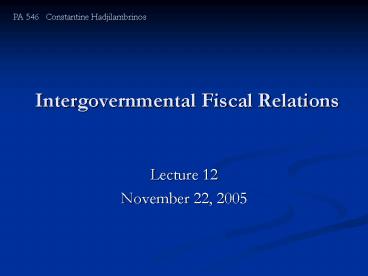Intergovernmental Fiscal Relations - PowerPoint PPT Presentation
1 / 13
Title:
Intergovernmental Fiscal Relations
Description:
... in tax base use Deductions and credits for tax paid to one unit in tax owed to ... Tradition of local control of primary and secondary education. ... – PowerPoint PPT presentation
Number of Views:81
Avg rating:3.0/5.0
Title: Intergovernmental Fiscal Relations
1
Intergovernmental Fiscal Relations
PA 546 Constantine Hadjilambrinos
- Lecture 12
- November 22, 2005
2
Correspondence
PA 546 Constantine Hadjilambrinos
- Identifies level of government that should
provide a service. - For each public good, the jurisdiction
providing the good should include precisely the
set of individuals that consume the good. - This is almost never practical, especially as
it makes little sense to have a special
jurisdiction for each and every public good.
3
PA 546 Constantine Hadjilambrinos
Subsidiarity
- Governmental responsibility for a function or
provision of a certain public good should be at
the lowest level of government that can deliver
it effectively.
4
Higher levels of government often argue that they
should deliver services because of economies of
scale.
PA 546 Constantine Hadjilambrinos
- The economies of scale argument makes sense for
capital-intensive services. - It does not make sense for labor-intensive
services. - It only makes sense for production of services.
5
Economies of scope
PA 546 Constantine Hadjilambrinos
- It makes little sense to have a separate special
unit of government for each service or public
good.
6
Fiscal disparity
PA 546 Constantine Hadjilambrinos
- Regional disparities in revenue production
capacity exist. - Higher levels of government can ameliorate
disparities through redistribution of revenue to
lower levels. - Sometimes lower levels of government can
cooperate in raising revenue through agreements
such as regional tax-base sharing.
7
Coordination and Assistance Tax Systems
PA 546 Constantine Hadjilambrinos
- Relief in tax base use Deductions and credits
for tax paid to one unit in tax owed to another
unit. - Assistance with revenue administration and
compliance. - Separation of sources (to prevent overlapping).
- Cooperative administration Continuous contact
and exchange of information. - Coordinated tax bases Linkages of tax
structures. - Tax supplements Lower level rate added to tax
base of higher level of government or use rate
that is a percentage of higher level tax. - Central administration Tax collection at one
level used by others.
8
Coordination and Assistance Grants
PA 546 Constantine Hadjilambrinos
- Transfer of revenue from one level to another.
- Conflict Recipient has little incentive to use
funds effectively. - Controls Strings attached
- But Grantor has little knowledge of
conditions at local level.
9
Categorical Grants
PA 546 Constantine Hadjilambrinos
- They finance specific and narrowly-defined
programs. - Administrative complexity.
- Program overlap and duplication.
- Distortion of local priorities.
10
Block Grants
PA 546 Constantine Hadjilambrinos
- They finance activities in broad functional
areas. - Fewer strings attached.
- Less control by grantor.
11
Revenue Sharing
PA 546 Constantine Hadjilambrinos
- General program fiscal assistance.
- No strings attached.
- Federal program ended in 1986.
12
School Aid from States
PA 546 Constantine Hadjilambrinos
- Tradition of local control of primary and
secondary education. - Substantial differences among localities in
preferences and in resources. - Flat grantsEvery district receives same amount
per pupil. - Foundation grants(3/4 of states) In proportion
to student population inverse proportion to
local property tax base per pupil. - Guaranteed tax baseEqualizes amount districts
would raise at the same tax rate.
13
Mandates
PA 546 Constantine Hadjilambrinos
- Address externalities of lower-level of
government action or inaction. - Provide greater uniformity.
- Costs of mandates can impact provision of
non-mandated services. - No cost-benefit considerations.
- 1995 Unfunded Mandates Reform Act.































